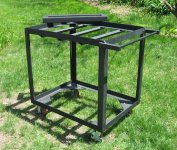AeroncaChamp
Cast Iron
- Joined
- Mar 2, 2007
- Location
- Westford, Massachusetts
Came into a stack of fire brick and an nice old iron vise - decided to build a rolling welder's table using the brick for a top surface and an iron plate across one end to mount the vise to and provide some metal surface for clamping work on.
I need to form a couple of rectangles out of angle iron with nice square corners and that lie flat. I have enough experience to know that this is likely to end up a warped mess if I just start welding the seams together, so...
Any tips or advice for how to set this up and approach to welding?
I have four of those magnetic angle blocks, plenty of clamps, and a good flat surface to start with. I thought I'd cut the best miters I can, square it up and get it flat, clamp the joints, tack the corners, nudge it around if necessary, then close the joints.
I've got an OA setup, nothing fancy, and a bit of experience gained at the school of hard knocks (putting an old wreck of a Chevy back together, which became my first car.)
I need to form a couple of rectangles out of angle iron with nice square corners and that lie flat. I have enough experience to know that this is likely to end up a warped mess if I just start welding the seams together, so...
Any tips or advice for how to set this up and approach to welding?
I have four of those magnetic angle blocks, plenty of clamps, and a good flat surface to start with. I thought I'd cut the best miters I can, square it up and get it flat, clamp the joints, tack the corners, nudge it around if necessary, then close the joints.
I've got an OA setup, nothing fancy, and a bit of experience gained at the school of hard knocks (putting an old wreck of a Chevy back together, which became my first car.)







